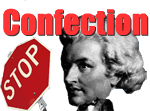Parts, Analysis, and Vision
 Breaking an idea or concept into its component parts is more than just a way of explaining it. This act of analysis defines just what that idea fundamentally is.
Breaking an idea or concept into its component parts is more than just a way of explaining it. This act of analysis defines just what that idea fundamentally is.
Say, for example,you were going to create a confection from one of the three following books about writing. The visual parts of the confection would differ depending on which book you chose.
Let's compare the table of contents (TOC) from Peter Elbow's Writing Without Teachers, Sanford Kaye's Writing Under Pressure, and Alistair Fowler's How to Write.
These three writers define the parts of the writing process in very different ways, and thus present three different visions of the writing process.
- Divide a piece of paper in thirds vertically into three columns, and write "Elbow," "Sanford," and "Fowler" at the top of each column.
- Choose one word or phrase from one of the tables of contents (TOCs) that seems characteristic of that book's approach. Write that word in that's author's column.
- Look for that word/phrase in the two other TOCs.
Does it appear anywhere else?
Do you see other words that mean something similar (but not the same)?
Enter those in the appropriate column.
- If you find that word/phrase, is it used differently? Write how it's used differently in that author's column.
- If you don't find it, what do you find instead? Make notes in that book's column.
- What does all this make you realize about the approach or "vision" of the book you started with? about one or both of the other books?
- Choose one of the three TOC's and try to describe in a few words how the parts of "dynamically relate" to one another.
Why do the early chapter topics come early, and the later ones come later?
Why does one follow another?
How does one support or extend the other?
How does the set of parts "move"?
Be ready to discuss what you find and realize.